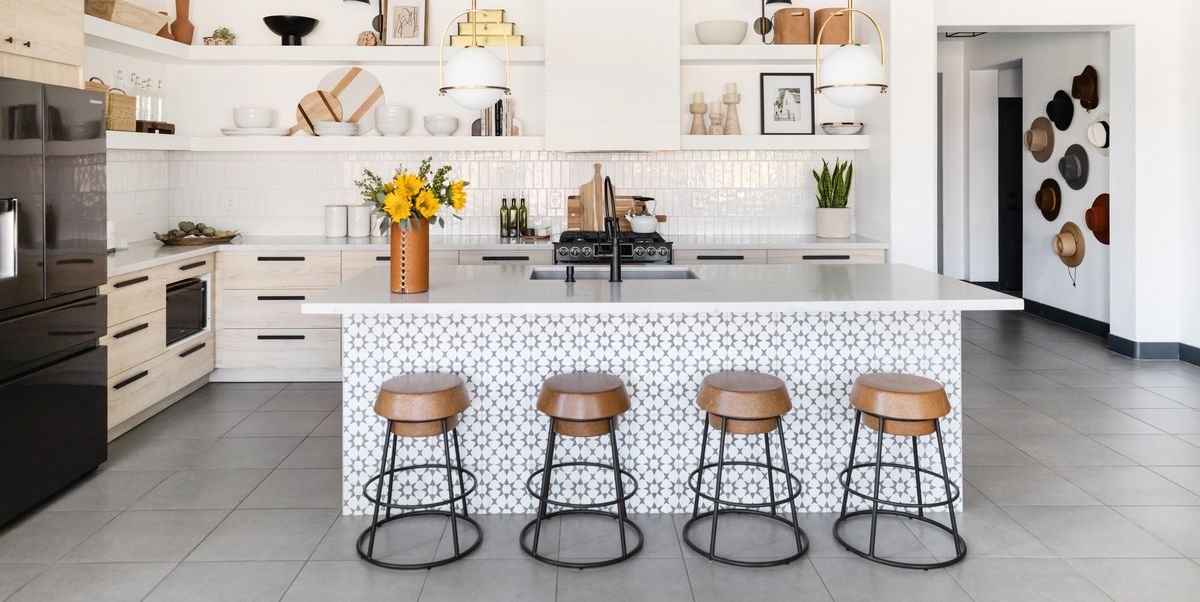A modern, functional home can benefit from thoughtful, inclusive design choices that make everyone feel welcome. Today, many easy ways exist to incorporate accessible home trends into high-traffic areas, like the bedroom, living room, and kitchen. Features such as lowered appliances, grand entryways, curbless showers, and open-concept layouts can make your home inviting for wheelchair guests or others with various disabilities.
Many accessible interior design trends we share below can even work for small spaces. We checked in with interior designer Maegan Blau, founder and principal designer of Blue Copper Design, a firm specializing in barrier-free design, and Linda Hayslett of LH—methods for tips and tricks on crafting an inclusive home. After a spinal cord injury left Blau in a wheelchair, she has been on a mission to create accessible layouts as beautiful as any other design trend. Below, you’ll find some of her famous and elegant ideas. One of her best pointers? Installing low kitchen shelves, cabinets, and microwaves. “This is our top suggestion to make kitchen storage more accessible for all,” she says. “We always say, ‘If you can’t reach it, let’s make it cool!'” You’ll find suggestions for the bathroom, like ledge-free walk-in showers, low pull-out cabinets, and an expert tip for an office layout.
We hope these accessible design trends will serve as inspiration for your own space, especially if you’re embarking on a home renovation.
Accessible Appliances
“Having a lowered microwave gives easy access to all, including kids,” Maegan Blau says. She also recommends a counter-depth fridge with customized shelves and a stove with knobs to prevent burning. “The overhang makes for a great prep spot to roll under and all the lighting uses smart light bulbs so they can be controlled from anywhere.”
An Accommodating Kitchen Island
The minor details can modernize and make your kitchen or dining area more inclusive for others. Take this impressive kitchen, for example—Linda Hayslett of LH. Designs installed the island with a second level so a client’s grandmother could eat at the dining table. “She doesn’t have to think about getting up on a bar stool, and no one worries about her falling over,” Hayslett says.
Curbless Showers
“We are seeing curbless showers as a big trend in bathrooms, not only for functionality but also for the luxurious look,” says Blau. They create a seamless floor transition that’s barrier-free and perfect for aging parents or wheelchair clients. Eliminating your walk-in shower’s boundaries and raised edges can turn your bathroom into an oasis. There are fewer nooks to clean, and this can make even the smallest of bathrooms seem more spacious. “It exudes luxury with a fun twist,” she says.
Extra Seating
A simple task, like putting on your shoes, can be difficult for people with limited mobility. Adding seating where people typically remove their boots or outdoor items, such as a mudroom or entryway, makes it easier and faster to get out the door.
Wide Furniture
“Having furniture pieces — like desks that have wider openings for any type of chair — help make the space seem like anyone can use it, while keeping a pretty aesthetic,” says Hayslett. For this project, LH. Designs custom-designed desks to have wider openings for a client’s grandmother who lived with the family. “Having to think ahead to help accommodate a possible wheelchair really puts the family at ease with the desks,” she explains.
Utilize Bathroom Drawers
Lower pull-out drawers and cabinets in the bathroom provide easier access to bath essentials, cleaning products, and hair accessories. Moreover, a lower sink and a bench are functional ways to wash your face, look in the mirror, and prep for the day while seated.
Grand Entryways
“When looking to adapt your home for accessibility, a large entryway makes for a very easy transition into the home,” says Marie Flanigan, principal designer of Marie Flanigan Interiors. “Plus, the entryway flooring in this home is the same as the exterior.” This makes moving from outside to inside a seamless experience, while the double doors “make for a grand visual while accommodating all visitors,” Flanigan says.
Open-Concept Spaces
With an open-plan space, you can eliminate the need to walk through crowded hallways and doors. Combining high-traffic areas, like the kitchen, dining area, and living room, provides a simple shift between sections for those with various disabilities.
Open Shelving
While open shelving forces you to stay organized, they’re also ideal for people with mobility issues. These shelves eliminate extra movements, like the need to open and close cabinet drawers, and provide ample space for their most-used items to be displayed. This can mean they have a clear view of their spices, pans, and cooking essentials in the kitchen.
